A History of Shops in Woodley
The 1847 Kelly’s Directory of Berkshire described Woodley as “a scattered village and consists principally of farm houses”. It gave the names of all the local farms, pubs and their owners, but did not list any shops.
By 1854 there were 3 shopkeepers listed in the directory: David Chandler, Joseph Eaton and Thomas Mundy. In the 1851 Census, Joseph Eaton and his son Gilbert were grocers living in a cottage in Bulmershe. The shop was probably the front room of his cottage. He also worked as a farm labourer.
In the second half of the 19th century, Kelly’s Directories listed a William Penn: bootmaker, Charles Clarke: hurdle maker, George Adey: dairyman, George Aldridge: baker and post office at Cobblers City and Elijah Brown: grocer.
The Post Office above was at Cobblers City, on the corner of Headley Road East and Tippings Lane. Cobblers City was an area of tradesmen like carpenters, furniture makers and shoemakers. George Aldridge had a bakery as well as the Post Office. The bakery was famous for its Zilvo flour.
George Aldridge went into partnership with Mr Albert Lee who had a bakery on Headley Road near the Recreation Ground. In 1908 a fire burned down the grocery shop in front of the bakery.
In the 1920s Woodley grew as houses were built along the main roads. The 1928 Kelly’s Directory listed the phone numbers of local businesses for the first time:
Aldridge, Ernest Wm beer retailer and post office
Aldridge and Co bakers tel. Sonning 2
Cooper, Herbert dairyman, Headley court.
George, Chas Allen builder tel. Sonning 56
Merritt, Maurice boot repairer
Paddick S. and Co. builders
Petherbridge, Chas motor engineer Sonning cutting
Richardson, Roland dairyman Fosters Lane
Russell, Harry plumber tel. Sonning 80
Russell, William cycle agent
These were local shops for local people and presumably everyone in Woodley knew where they were! There was no shopping centre.
The Palmer estate at Holme Park was sold in 1910 and the Bulmershe estate in 1926. These sales released land for building houses. The development of Woodley Aerodrome in the 1930s brought new people to live in Woodley.
From the 1940s the Post Office was at 60 Headley Road. Ernest Aldridge ran it, then Mr and Mrs Shirvington, then Mr and Mrs Lamb. There were other Post Offices at Shepherd’s Hill and Loddon Bridge Road.
By the 1930s shops were built along the main roads in Woodley and listed by address and phone number.
The first shopping centre of Woodley was in Headley Rd. 1940 Kelly’s Directory listed:
Ernest William Aldridge, post office and beer retailer (off licence) Headley Rd.
George Campbell Audsley, drug store and confectioner at Restholme Stores. Patricks drapers, prop. Mrs D. Lawes was at Wayside in Headley Rd.
Bernard Hemsworth’s grocery shop was Waverley Stores and it was the agency for Thames Valley Traction (the local bus company) parcels.
Robert Edwin Storr, cycle repairer at Clanfield in Headley Rd.
Woodley Pharmacy run by Miss Z. Novack.
The Reading Retail Co-operative Society shop and Bill Russell’s garage were in Headley Road in the 1950s. Mr and Mrs Shirvington ran the Post Office and drapers. There were two butchers P. W. Agate and Sons and Francis Brothers.
Richard Smith remembers cycling to the shops in Headley Road “As he grew older he was entrusted with helping with the family shopping. In the earliest times that he did so, he had to take the ration books with him, a situation that was continued until 1955 when meat rationing finally came to an end. Many were the times that he struggled home with heavily filled bags, one hanging on each side of the handlebars.
Fortunately, living in a bungalow in Wood Way, meant that the shops in Headley Road were local. In those far off times most of the retailers sold ‘branded’ goods at exactly the same prices”.
By 1970 there were fewer shops in Headley Rd because of competition from the new precinct in Crockhamwell Road. The Co-op was at 6 Headley Rd. International Stores at 88 –on the Just Tiles roundabout. 38 was Job’s dairy, 56 was the Woodley Motor Company and 58 was Wood Racing turf accountants, K C and S M Lamb, drapers and PO at 60, E J Miles newsagent 72 and Marie Ladies hairdresser at 86 Headley Road.
The first shop in Crockhamwell Road was Bertie and Beatrice Ambrose’s fish and chip shop in 1939. Their grandson Bob Turner remembers delivering fish to The Falcon Hotel on Reading Aerodrome on Saturdays. The shop was next to Maxwells and the Co-op.
Other new shops joined them in the late 1940s: Woodland and Kemsley Stores: both grocers.
The first stage of the Crockhamwell Road shopping centre was developed in 1965.
In 1964 the Wokingham Rural District Council minutes (It was the local authority before Woodley Town Council) proposed a development opposite The Chequers pub for 6 shops. Work was to start in October 1964. Later they added 10 shops and 2 supermarkets on the other side of the road, to be let at annual rent of £900-950.
The first phase was completed in 1965. The shopping area was not pedestrianised until later. The Woodley and Earley Society recommended rerouting Crockhamwell Road to make it a pedestrian centre in 1965. Taylor Woodrow, the developers, gave the clock in 1971 to the shopping centre.
The airfield development planning brief in the mid 1970s suggested it would be a possible site for a new shopping centre. Brett and Pollen Consultants commented on the scattered shops in Woodley but said of Crockhamwell Road:
“two important parades of shops have been built including 2 supermarkets …and 4 banks”. In the end, they decided to concentrate shops in Crockhamwell Road and build a local shopping centre: Loddon Vale in Hurricane way for people living on the airfield site.
Several councils houses were demolished to make way for it and St John Bosco RC church was moved from Crockhamwell Road to Western Avenue.
The photo shows it before pedestrianisation.
Photo courtesy of The Reading Evening Post
Early supermarkets were Home and Colonial and Keymarkets in Crockhamwell Road.
In 1960 there were two banks in Crockhamwell Road: Barclays and the National Provincial. By 1970 the development of Crockhamwell Road was well under way. They were joined by the other big banks: Midland and Lloyds. The National Provincial merged with the Westminster bank to become National Westminster.
Jackie Powell worked in Lloyds and remembers when it was a caravan with one guard and a cashier, outside Maxwells. John LeMesurier came into the bank when filming the Dad’s Army pelican crossing film.
There was also Thames Valley Trustee Savings Bank, Southern Electricity Board showroom and Southern Gas Board. There were supermarkets: Keymarkets at 176, Home and Colonial at 130, Liptons and Maypole grocers. Maxwells was at 57-61, Modern Butchery at 69, Dewhurst butchers at 156, Arthur Cooper wine merchants, Milwards shoe shop, an automatic laundry, a dry cleaners, Heppells the printers, Fry’s Fisheries – fish and chips- and Parslows, the bakers whose factory was in Loddon Bridge Road. The Woodley Radio and Television Co. Ltd. Dolley’s wool store, Church’s and Knight’s newsagents, chemists and 2 greengrocers: Gerrards and Fruit Fare. Lesley Heaney remembers Darth Vader visiting Beatties Toy and Model shop.
In the 1970 Kelly’ Directory, the Home and Colonial supermarket was near the Chequers at 130 Crockhamwell Rd. Later it became Freelance Fabrics owned by Fred Potts. Brian Pugsley had a Saturday job in Keymarket at 170 Crockhamwell Rd. He was paid £1.00 for the day. Molly Woodley worked there for a week before going for a job interview at Waitrose, who paid more. She worked 20 hours a week from 1967/8 to 1992, when she retired. She was on the tills, then in the wine department. Another staff member was Mrs Ethel Woodley – no relation.
Maypole grocers and Liptons were in Crockhamwell Rd. The Co-op in Headley Road was demolished to make way for the Lidl block. The first Waitrose was where Iceland is now. It moved to bigger premises across the road. It was still too small so it took over the adjoining shop where the food and vegetables are now.
Maxwells is fondly remembered by Woodley residents. It was started by Max Steggles in the late 1940s and closed in 1995. He started the Woodley Carnival in 1960.
In 1995 Crockhamwell Road precinct had 6 banks, 1 building society, 3 travel agents, 3 grocers, 2 bakers and 1 butcher,2 confectioners, newsagents and tobacconists, 2 florists, 2 shoe shops, 3 women’s clothes shops, 2 booksellers, 2 toy, cycle and sport shops and 1 café. In the 21st century, many of the shops are coffee shops and charity shops.
Before most people had cars, there were local shops in Colemansmoor Road, Loddon Bridge Road, Headley Road and Shepherd’s Hill.
Colemansmoor Road had 2 grocers in the 1930s. One was owned by Charlie Atkins and went out of business by 1940. The other, run by Hereward Summers then by his widow Gladys at 140 Colemansmoor Road, closed in the 1960s.
A new parade of shops was built for housing estates in Brecon Road, Coppice Road, Ravensbourne Road and Loddon Vale Centre for the airfield development.
Brecon Road shops in the 1970sPhoto courtesy of B. Horder
Mortimers grocery shop and Post Office was at 186 Loddon Bridge Road, run by William Mortimer and later by Sheila and Ron Kernutt. The area was known as Wheelers Green and was the site of the village pond. It is now occupied by Berkshire Bicycles.
Jesse Goffe ran Bulmershe Stores, the Post Office and grocers, tobaccconists and confectioners at 143 Loddon Bridge Road. This was in the parade which now has The Good Companions pub.
Retail Price Maintenance was abolished in 1964. The law had enabled small shops to be profitable by making all shops sell goods at the same price. But it kept prices high. Abolition and the growing popularity of cars meant that local shops could not compete with supermarkets. By the 1970s local food shops in Loddon Bridge Road and Headley Road had become estate agents, hairdressers and solicitors.
Photos courtesy of Reading Library’s local illustrations collection, Memories of Woodley Facebook group and Woodley Town Council guides.
The Fountain: Woodley’s Oldest Shop
Many Woodley residents know about the local landmark at 299 Headley Road where it joins Tippings Lane: The Fountain off licence sign.
But did you know that it marks the site of Woodley’s oldest shop?
It all started in1882 when George Aldridge became a baker. He is listed in the Kelly’s Street Directory of that year.
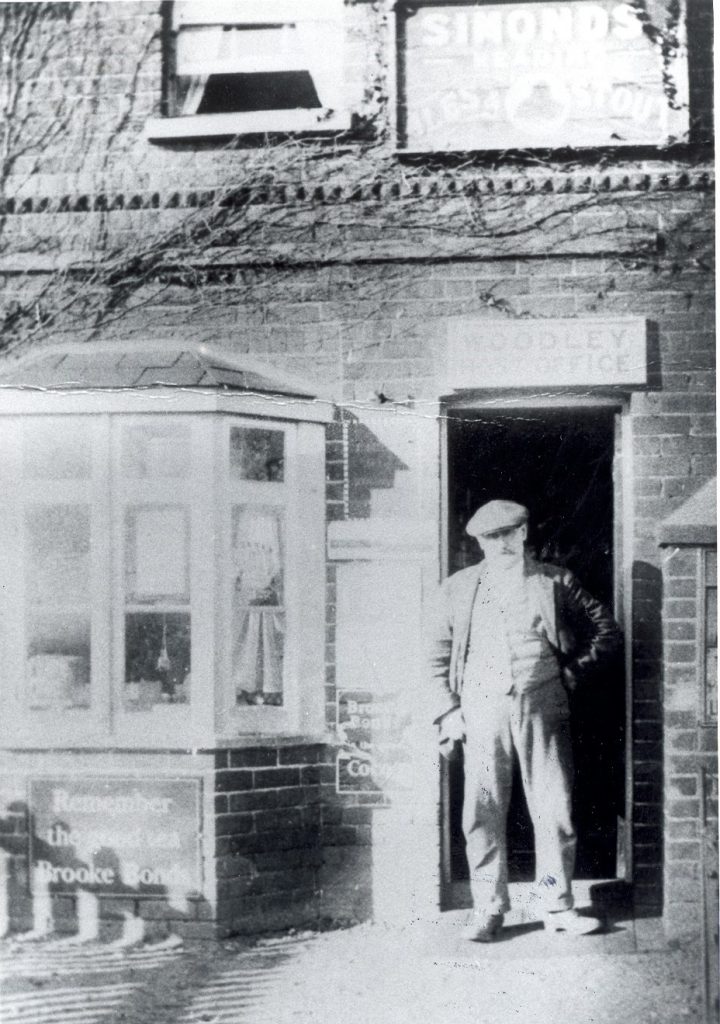
Woodley Post office and Off Licence in Cobblers City. Date unknown, probably 1900. See the Simonds sign over the door. Photo courtesy of Reading Central Library.
In 1897 George Aldridge and Sons baker were listed in Kellys Directory. In 1907 the bakery became the Silver Flake Flour Company, Zilvo Factory in Cobblers City. They had a flourishing business delivering bread to local people. By 1907 George Aldridge was also the sub postmaster. He had taken over from John Wadhams who had been the postmaster, the parish clerk and blacksmith in the late 19th century. The Zilvo factory was still in business in the 1930s but had closed by 1949.
The name The Fountain was first recorded in Kelly’s Street Directory 1915: E. W. Aldridge, beer retailer, The Fountain and George Aldridge, the stores, post office. George was a churchwarden at St John’s and a rural district councillor and had retired or died by 1920. The Fountain was then run by his son E. W. Aldridge.
In 1928 Ernest William Aldridge was a beer retailer and ran the post office, and Aldridge and Co were listed as bakers. Their phone no was Sonning 2. He died and in 1942 the shop was bought by Henry Edgar Lee (known to his family and friends as Jim) and his wife Elsie. The fittings were valued at £61 14s 6d. We know this because his grandson Mike Lee still has the valuation document. Henry Lee was born in The Pitts, cottages which used to be part of the old Woodley workhouse in Cobblers City. There were wartime restrictions from The Ministry of Food about what he could sell. You can see from the photo that it was strictly limited!
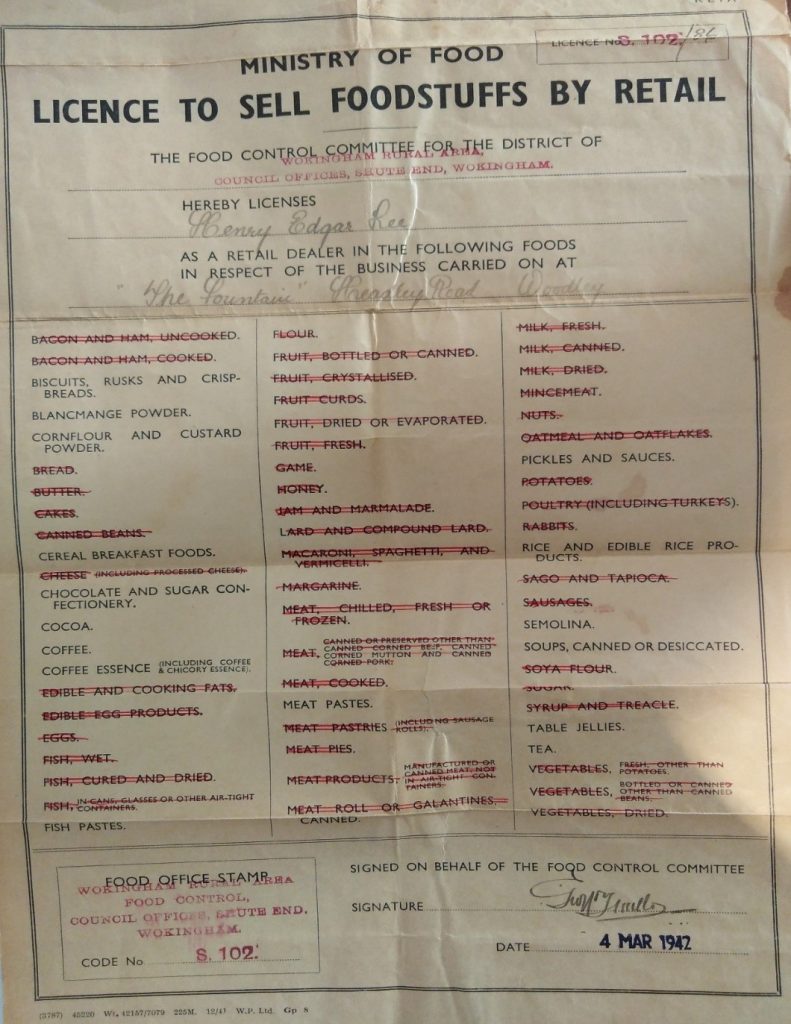
He ran it as a Post Office, off licence, cigarette and sweet shop until he retired in 1979. The business was owned by Simonds the brewer. Later Courage took it over. There was a GR post box at the front of the shop and a phone box through the gate outside the back of the shop. The Post Office part of the shop had gone by 1949. Henry and Elsie Lee lived in the house next door at 299 Headley Road. There was a door between the house and the shop. During WW2 they took in lodgers.
They had a long- standing lodger called Bill Gorringe. Mike Lee remembers a model railway in one of the bedrooms. They also looked after an elderly couple: Mr and Mrs Woodcock who lived in a caravan behind The Fountain. In 1945 they hosted a VE day party behind The Fountain.
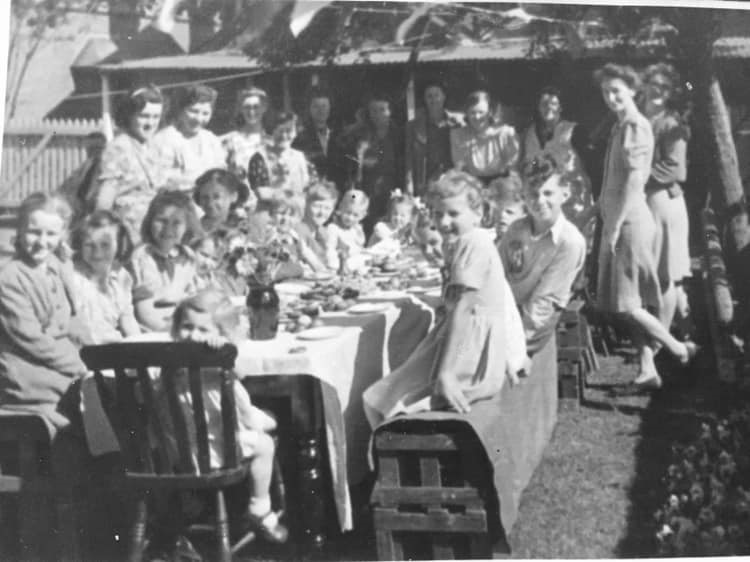
Generations of Woodley residents remember buying their sweets in paper bags from The Fountain. There was a long wooden counter with drawers. Money was kept in one of the drawers. Alcohol was sold from behind a glass screen at the back of the shop. In the days before bottles and cans of beer it was sold from a tap. You had to bring your own container. The opening hours were 10-12 and 6-9 pm.
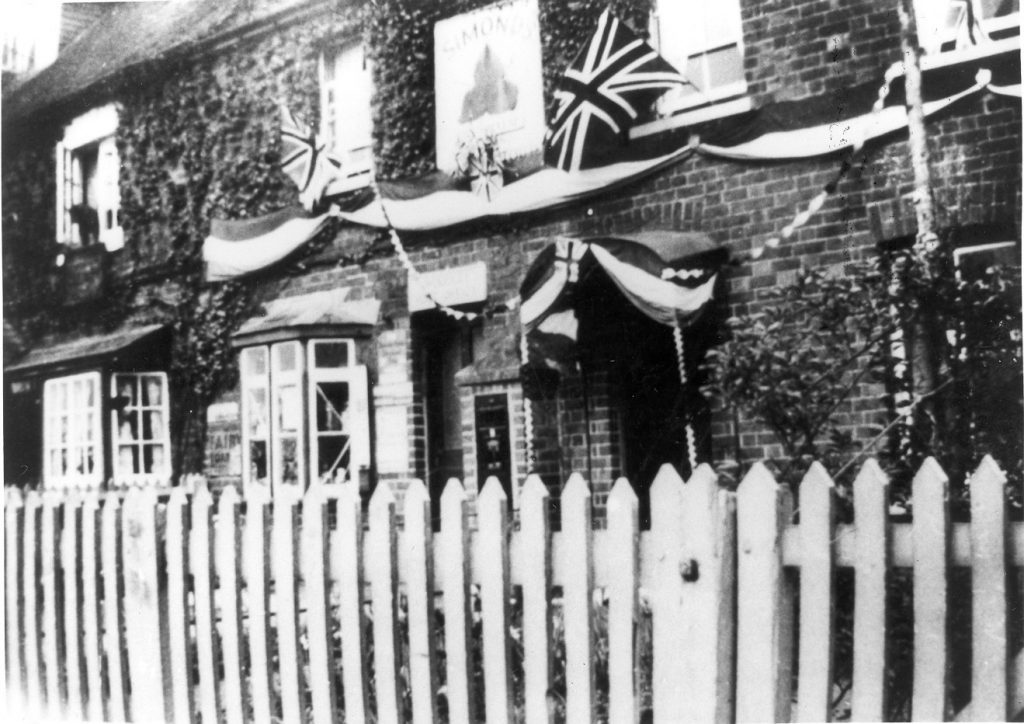
The Fountain decorated for the 1953 coronation. Photo courtesy of Reading Central Library
Mike Lee remembers his grandfather as friendly and chatty and his grandmother as strict.
The Fountain had a long back garden with a barn as well as a caravan. Mr Lee was a keen gardener who grew fruits and vegetables, kept chickens and a pig. His front garden was filled with beautiful bedding plants. He won prizes from Courages in 1963-5 for his garden.
When he retired in 1979, he and his wife continued to live next door to the shop. It was taken over by Mrs B. J. Parnell from 1979-81.
Gordon Arthur James Lee was born in 1929 (Mike’s dad) in Poplar Cottages. It was bombed in 1940. See the map for below.
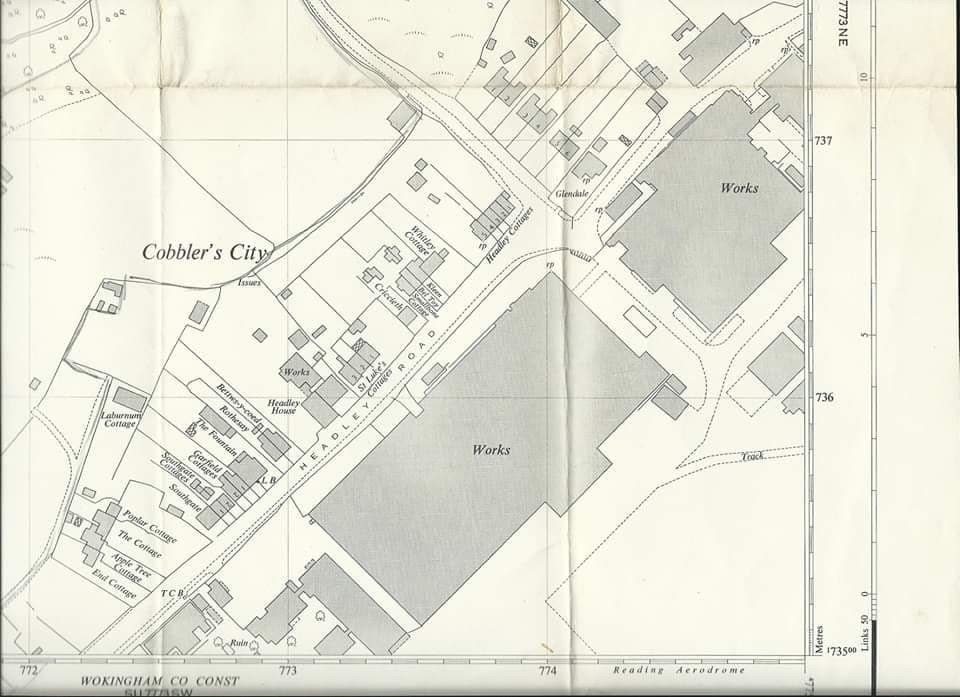
He married Molly and worked at Lebus the furniture factory in Headley Road. They lived in Butts Hill Road. He was made redundant from Lebus in 1981, so he changed career and took over the shop.
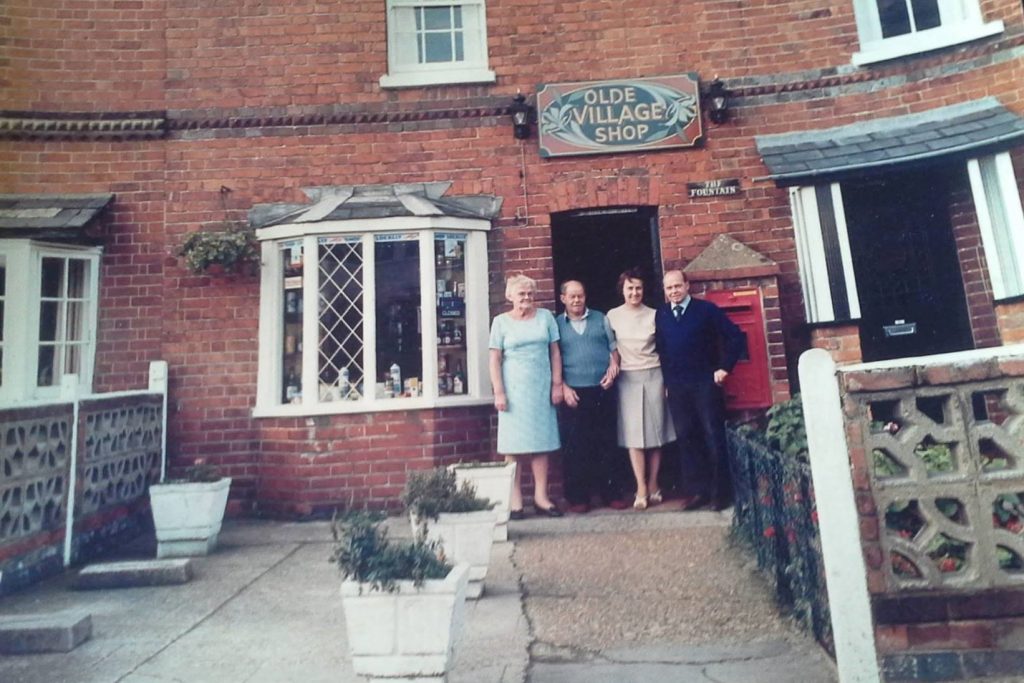
The Fountain early 1980s with Mike Lee’s parents and grandparents. Photo courtesy of Mike Lee
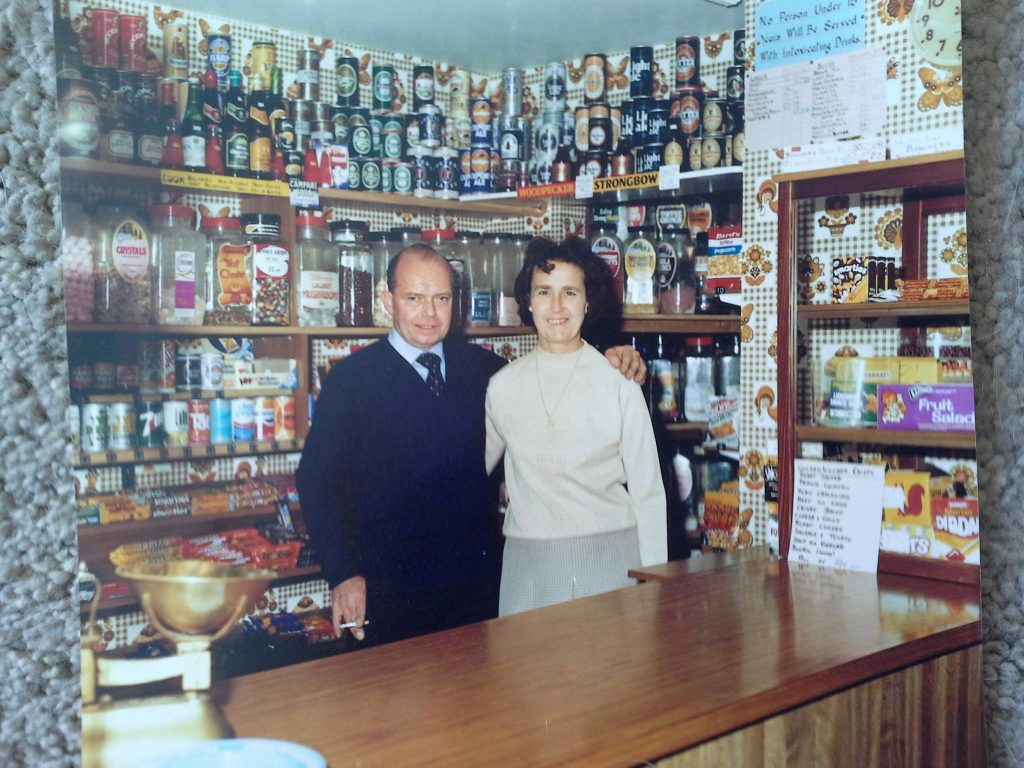
Inside The Fountain with Mike Lee’s parents Gordon and Molly. Photo courtesy of Mike Lee
Gordon Lee gave the shop a new lease of life, put up Ye Olde Village Shop sign and introduced a cash till to replace the old drawer for money. The shop was run by Gordon and Molly Lee . After his death, in a car crash in 1983, the shop opened just in the evenings for 18 months. Then there was a series of owners who did not stay long. H E Lee died in 1985 and Elsie Lee died in 1992. She still lived next door but the shop was empty by then. The last mention of The Fountain in Yellow Pages was in 1986.It had been in business for just over 100 years. The development of Woodley Airfield and its new shopping centre, the increasing use of cars to shop at supermarkets, and the closing of factories in Headley Road meant it was no longer a viable business.
Both Henry Edgar Lee and his son Gordon played for Woodley Football Club. The Fountain was a meeting place for Woodley FC supporters.
The Fountain was sold in 1993 to a developer for £77,000. He built a house where the drive had been next to 299 Headley Road, and 2-3 houses in the back garden which were accessible from Headley Close. But the builder kept The Fountain sign, so you can still see where Woodley’s oldest shop was.
Information and photos kindly supplied by Mike Lee.
